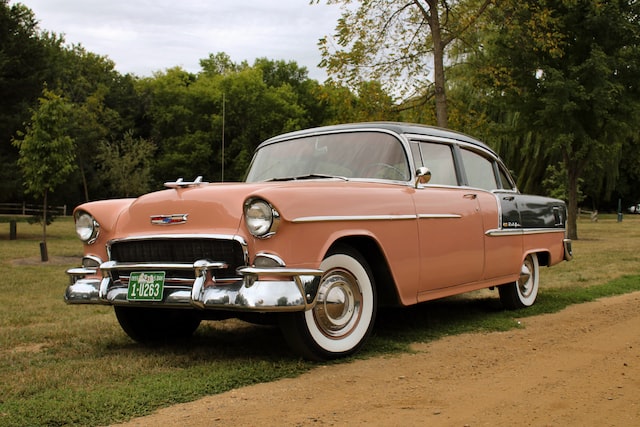A lane is a part of a roadway that is divided along the length of the road with a width sufficient for safe driving. A driveway may have one or more lanes, each of which is distinguished by road markings or medians in between. Driving on a motorway or one-way road may be easier for drivers, but a car driver’s negligence can easily make lane-changing mistakes, even putting them in dangerous situations. Many tragic accidents have happened because of errors related to lane change. Even if all drivers are required to pass a driving test before being officially licensed, changing lanes is still a challenge due to the lack of actual driving experience. In this article, we will cover the effective tips for changing lanes.
How To Change Lanes Safety and Accurately?

Going in the wrong lane is driving a vehicle to the wrong lane for on a road segment divided into many lanes and separated by road markings, each lane is only for one or a certain type of vehicle. To ensure safety during the process of driving and avoid unnecessary mistakes of changing lanes, it is recommended for you to keep in mind the following experiences:
- Observe carefully
Before changing lanes, the driver needs to look carefully, especially check the rearview mirror on the side of the lane you want to change. People need to consider whether the lane to be changed is clear, if there are obstacles, if there is a vehicle behind that is approaching, what is the speed of the vehicles behind, etc. Only change lanes when it is safe to do that.
- Must have a warning signal
When changing lanes, the driver must turn on the warning signal and ensure safety. Turning on the warning signal will help notify the vehicles behind to have an appropriate handling plan. If they are approaching, they actively slow down to give way to vehicles changing lanes.
- Only change lanes when allowed
On roads with multiple lanes for vehicles traveling in the same direction separated by lane markings, motorists must keep their vehicles in one lane and change lanes only where permitted.
- Avoid sudden lane change
Arbitrarily changing lanes can lead to traffic accidents because the speed of vehicles on the highway is often high. Vehicles behind need time to recognize the vehicle you are trying to change. If you suddenly change lanes, the vehicle behind may not be able to handle it in time, leading to a collision.
Drivers are only allowed to change lanes where there are road markings indicating permission to change lanes and turn on the turn signal. Should keep a reasonable speed, run with suitable conditions to observe the following vehicle, and do not run into the blind spot of the vehicle ahead. When you find the right time, change lanes decisively, without abrupt steering or sluggishness.
- Change lanes definitively
After giving the signal and starting to change lanes, it is necessary to change lanes decisively. Absolutely do not hesitate, do not maintain a half-lane halfway. This will interfere with other vehicles traveling on the same road, which is very dangerous. In case the lane to be changed has many vehicles, there is not enough space to enter the lane, it is best to maintain a safe speed in the current lane and wait until it is safe to change lanes.
- Avoid changing multiple lanes at the same time
For roads with many lanes, it is not advisable to change multiple lanes at the same time. Because the driver will be very difficult to observe, difficult to control the situation. It is recommended to switch lanes one by one in order to ensure the safety of both drivers and other people on the road.
- Only change lanes if necessary
Drivers should only change lanes in necessary cases such as when they want to overtake, want to accelerate (into the higher speed lane) or slow down (into the lower speed lane), want to change direction, pull over to the curb… Otherwise, a steady speed should be maintained in one lane. This not only helps to ensure safety but also does not interfere with other vehicles.
Read more >> Tips For Driving In Rain You Should Remember
- Check for blind spots when changing lanes
Drivers should not skip another important step, blind spot checks. It is advisable to take advantage of the blind spot warning system if your vehicle is equipped with this feature. If your vehicle does not have the above system when changing lanes check the blind spot by Turning your head to the left and looking to the side of the B pillar when changing lanes or turning your head to the right and looking at the edge of the pillar C when changing lanes to the right. Only by looking through the rearview mirror, you can hardly see these 2 blind spots clearly.
- Maintain suitable speed
If you are stopping and starting to change lanes, drive slowly. This helps the cars behind to recognize and avoid and slow down when necessary. The driver’s foot should be in the V-position, the heel should be in the brake pedal position to prevent unexpected obstacles.
If changing lanes on an expressway from a low-speed lane to a high-speed lane, you should first accelerate gradually to level with the vehicles in the lane you want to change. When you reach a safe distance from the vehicle behind you, you will change lanes. The lane change action must be decisive. If you change lanes at too low a speed, your vehicle may obstruct other vehicles behind, which is very dangerous.
After entering a new lane, do not suddenly decrease or increase speed, which will make it difficult for surrounding vehicles to judge and yield. Therefore, experts recommend maintaining a steady, reasonable speed when changing lanes.
- Always turn on the signal light
Before entering/changing lanes, drivers are required to turn on the turn signals in the direction they want to change. Normally, it is advisable to turn it on about 3-5 seconds before starting to turn the steering wheel so that the vehicles behind you can recognize it. Many traffic accident situations occur because the driver has finished turning on the turn signal and changed lanes right away.
- Keep distance from the car in front
To keep a safe distance, do not follow the tail of the vehicle in front. However, please note, when driving in bad weather conditions, with limited visibility (fog, heavy rain, slippery roads) you need to increase the safe distance. The minimum safe distance according to regulations on Vietnamese highways is 50 m.
- Keep distance from the vehicle in the lane next to you
On a highway with many lanes, you should keep a distance from cars in the lane near your car. It is advisable to keep a distance of 1 to 2 bodies from vehicles in the adjacent lane. That way, if any vehicle running in the adjacent lane has a problem and needs to steer or change lanes suddenly, they won’t hit your car and you can simply handle it safely.
- Predetermine the stopover
On the highway, there are often rest stops for the vehicle in trouble or for tired people who want to rest. You should not suddenly cross the front of a series of cars in the lane close to the curb to get to the stop. It is necessary to determine the position in advance, then turn the signal and gradually move into the most appropriate lane closest to the stop.
Besides, many people, after stopping on the way, climb into the car and press the accelerator to enter the traffic lane without knowing what is behind. Drivers need to calmly observe front and back, turn on the signal to enter the lane until the approaching vehicles recognize and show signs of giving way, then slowly enter the lane.
If you want to get more information about road rules, visit our website and try the free DMV practice test to grasp all the necessary information to be safe on the road. Or can download it for your IOS or Android devices to study at any time!
How To Recognize Lane Change Signs?

Nowadays, there are numerous methods of dividing the lanes so that drivers can easily recognize driving mistakes. These can include lane directional signs, lane markings, or several other methods. Below are the most popular ways of lane dividing for you to keep in mind:
- Lane directional signs
Usually, when in front of you is a highway or a one-way street, there will always be a signpost. The responsibility of this sign is to help you keep track of the situation, thereby preparing you to keep your way without making any mistakes. In addition, it is necessary to pay attention to the signs prohibiting U-turns because sometimes on a two-way street, the driver wants to turn back but is not careful enough to turn the car in a prohibited position. However, many inexperienced drivers often ignore these road signs.
- Lane markings
In addition to lane indication signs, road markings are also one of the factors that drivers need to pay attention to when changing lanes. Road markings are defined as a form of signaling to guide and control traffic in order to improve safety and possible traffic capacity, including lane markings. Therefore, road users must be responsible for obeying the road markings. Road markings are divided into two types: horizontal lines and vertical lines.
- Broken White Line
This line is used to divide lanes for motor vehicles; dividing the road allowed to move for rudimentary vehicles and motor vehicles. These broken longitudinal lines help the driver distinguish the lanes and keep the vehicle moving in the right lane.
- Solid White Line
Solid White Line is a type of line used to prohibit vehicles (motorized and rudimentary) not to exceed or overlapping that line. That is, if you exceed or overlap this line, the driver will be fined. The continuous vertical line is used to divide the road into two directions (going and returning) and to separate the road for rudimentary vehicles from motor vehicles. For roads with this type of line, the driver needs to be careful not to insert the line. In addition, it is necessary to pay attention to the signs prohibiting U-turns because sometimes on a two-way street, the driver wants to turn back but is not careful enough to turn the car in a prohibited position.
-
Broken Yellow Line
The dashed yellow line helps to divide two lanes of traffic traveling in opposite directions in road sections with 2 or more lanes and without a median strip in the middle, vehicles are allowed to cross using opposite lanes on both sides.
- Solid Yellow Line
A solid yellow single line helps to divide two-way traffic on roads with 2 or 3 lanes, without a median strip. Vehicles must not cross the line or cross the lane. For a single solid yellow line, used in road sections where visibility is not guaranteed, there is a risk of a head-to-head accident.
Read more >> How To Park A Car: 3 Common Situations Of Car Parking
- Double Yellow Lines: One Solid, One Broken
This type of line is used to divide two-way traffic for roads with 2 or more lanes, without a two-way divider, used in sections where it is necessary to prohibit vehicles from using the opposite lane in one direction. certain runs to ensure safety. Vehicles in the lane adjacent to the dashed line are allowed to cross and use the opposite lane when necessary, vehicles in the lane adjacent to the solid line may not cross the line.
NOTE: In addition, some places also use a tree belt instead of lane marking. So, even if you can’t see the road markings, you should be careful and watch closely.
Above are several effective methods of lane change for drivers when they have to change lanes. Hope this information can help you during the driving process to ensure the safety of both yourself and other people on the road.

UT Utah License Renewal: A 2025 Comprehensive Guide
Discover the ultimate guide to Utah license renewal! This comprehensive guide delves into the intricacies of renewing your driver's license in Utah,...
February 13, 2023

South Carolina S.C. Driver's License Renewal
The South Carolina S.C. driver's license renewal process is designed to be comprehensive, taking into consideration eligibility requirements, renewal methods,...
February 13, 2023

Pennsylvania PA DMV License Renewal: A 2025 Full Guide
The Pennsylvania PA DMV license renewal process is designed to be comprehensive, taking into consideration eligibility requirements, renewal methods,...
February 10, 2023

